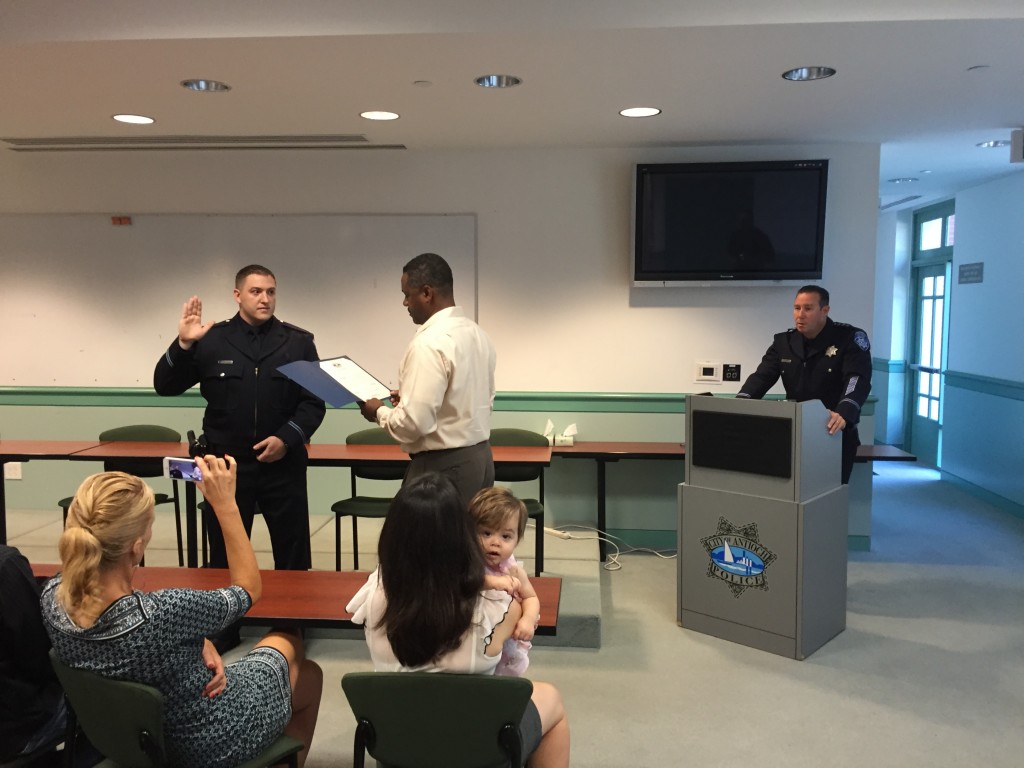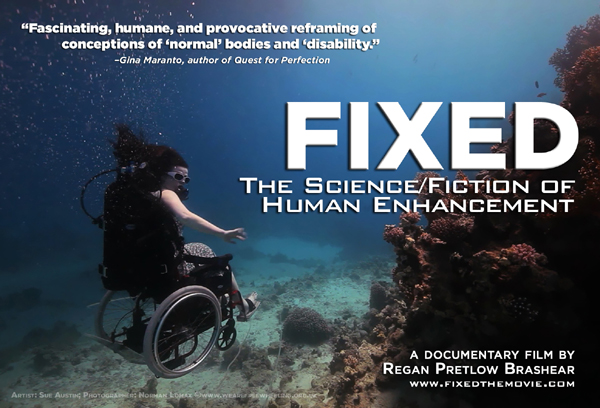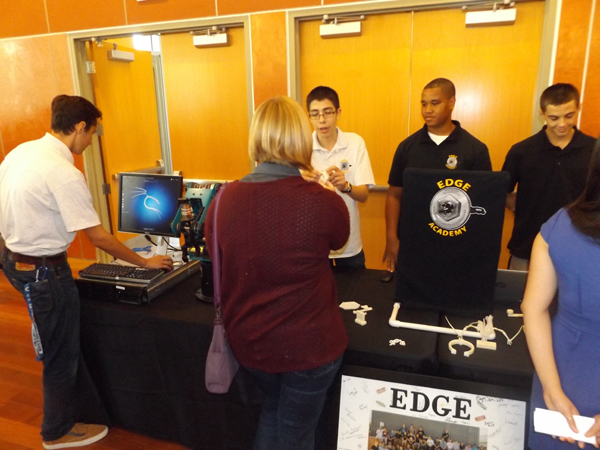
Antioch High School juniors Kevin Roldan, Darian Quinn and Robert Gochenouer speak with Amanda Hauf, a chemical engineer with Dow Chemical in Pittsburg, while junior Hudson Preece works the laptop at the EDGE Academy display.
By Allen Payton
Thursday’s Pathway to Pipeline event allowed high school students from the nine Linked Learning academies in Antioch to share what they’re learning with local employers. In turn, it provided the opportunity for those employers to talk with the students and offer them potential internships at their companies.
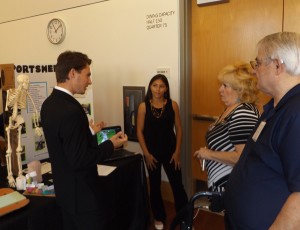
Dozier-Libbey Medical High School juniors
Joshua McEvoy and Adriana Uritia share about their SportsMed class with Karen and Bob Martin.
Sponsored by the Antioch Unified School District, Antioch Chamber of Commerce, City of Antioch and the East County Business-Education Alliance, the event, held at the Antioch Community Center at Prewett Park, was held for the purpose of building the region’s future workforce. Launchpath, an effort of the Foundation for California Community Colleges and the Linked Learning Alliance, was instrumental in supporting the day.
During the morning, the students from the nine academies shared what they are doing and learning at school. Those academies include the Dozier-Libbey Medical High School, with booths about the school in general and their SportsMed class. The Business-Tech Marketing, Law and Justice, ACE Bio-Tech, Performing Arts Academies of Deer Valley High School were represented, as were the Environmental Studies, Media, Leadership and Public Service (LAPS) and Engineering & Design Green Environment (EDGE) Academies from Antioch High School.
ACE is an umbrella for other pathways, and stands for Academic Challenge and Enrichment. It provides students with opportunities to become expert in a STEAM field of their choice. STEAM is an acronym for Science, Technology, Engineering, Arts, and Mathematics.

Deer Valley High students, junior Jafar Khalfani-Bey, center and senior Rahmat Omari, speak with Antioch business owner Ken Turnage at the Law & Justice Academy display.
Academies on Display
The EDGE Academy students had a 3D printer on display, creating a plastic toy from a design file found on a website, which they had downloaded to an attached laptop.
It took about 30 minutes to create the one-inch tall toy.
According to junior Hudson Preece, the students are trying to resurrect an older server to help make the 3D printer, that they can use to sell products they make, on a website they plan to set up, and to update the software to make metal objects, as well.
Also on display was an old robotic arm from the early 1990’s, from one of two inactive assembly lines.
“We’re looking to update it and integrate it into newer computers and software so that it’s usable for the freshmen to integrate it into their curriculum,” Hudson added. “We want everyone in the EDGE Academy to use these tools to further their education.”
“They’re little layers of plastic,” explained junior Robert Gochenouer. “It’s 0.5 of a millimeter per layer.
“The plastic is heated like in a glue gun,” said junior Kevin Roldan.
The students use designs they find online and sell their creations.
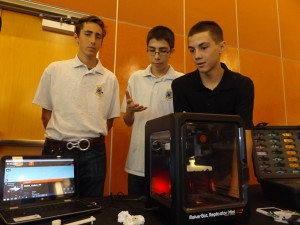
Hudson Preece, Kevin Roldan and Robert Gochenouer, juniors in the Antioch High EDGE Academy explain the workings of the 3D printer at their display.
“Or you can create your own design,” Robert added.
New to the school in Fall, 2014, the printer they had on display costs about $1,000 to $2,000.
“The teachers gave it to us and said figure it out,” Hudson said.
“They have a bigger printer that can print the larger items and more accurately,” said Darian.
“That one cost roughly $17,000,” Hudson added.
Students in the Business-Tech Academy are starting a new, virtual enterprise that will be international, buying and selling products, as part of an online simulated economy.
“We were doing college textbooks,” shared senior Miraya Finau, Vice President of the Virtual Enterprise. “But, we just decided this morning to switch to noble teen fashions.”
“The classes in there, right now, are researching marketing and what prices to charge,” she added.
The Marketing Academy students run their own on-campus store. On display they had ssome of the school-related products, and other items, such as sports-themed laniards, which they sell.
Success Stories
The half-day also provided the opportunity for those in attendance during lunch, to hear from Antioch Superintendent Dr. Don Gill and students who participated in an internships, this past summer.
“Linked learning works,” Gill stated. “When we had freshmen first come in to the EDGE Academy many of the students were underperforming.”
As a result (of their experience in the academy) those kids soared and those students reached the level of proficient and advanced,” he said. “Now, about 80% of students in the Antioch high schools are aligned to a link learning program.”
He thanked the James Irvine Foundation for providing $3.5M to Antioch’s linked learning program.
Gennie Barr, a Supervisor at Verizon praised the work of the three interns, over the summer.
“In 10 years I’m expecting them to be my boss,” she said. “I told them to give them work. Not just busy work. After six weeks I had everyone ask me ‘can we keep ’em?’”

Antioch High senior Matthew Hilton speaks about his summer internship at Verizon during lunch.
One of her interns was Matthew Hilton, a senior in the EDGE Academy.
“I had to do a resume. It was like a real job interview,” he said about the process for getting accepted into the internship. “I got to see what it was like to be with these firms. I was looking at different designs for cell towers. I actually took the place of a project manager before she left on vacation. It was a lot of work, essentially.”
“For the most part I was actually working there. I was shoving a 9 to 5 into a 9 to 3,” Matthew continued. “I got to see and prove I could make it in the business world. There was never a dull moment.”
Matthew ‘s father, Rick Hilton, offered his praise for the EDGE Academy.
“I’ve never seen a group of teachers who are more dedicated to their students than in the EDGE Academy,” he shared. “It’s not just the engineering teachers, but the others associated with the academy like the English and math teachers, as well. They definitely believe in the team teaching approach.”
Dr. Sean Wright, the CEO of the Antioch Chamber concluded the lunch time presentations with his thoughts.
“This isn’t the future of education renaissance. It is education renaissance,” he stated. “We need the business community to continue to support this.”
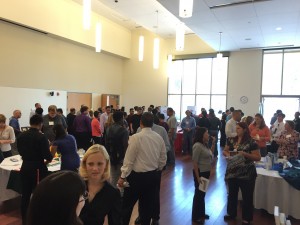
Local employers participated in the Antioch Careers Expo offering internships to students who attended.
Wright mentioned aspects of Linked Learning academies.
“It must be rigorous…raising the level of education,” he said. “It must be relevant. It needs to matter. It must be work-based learning to engage with us as business owners.”
After lunch, that’s exactly what students had the opportunity to do, as local employers participated in the Antioch Careers Expo, hosting tables at which they shared information and offered internships. Participating employers included those in the fields of real estate, health, law enforcement, government, technology and media.
For more information about LaunchPath, visit www.launchpath.com.
